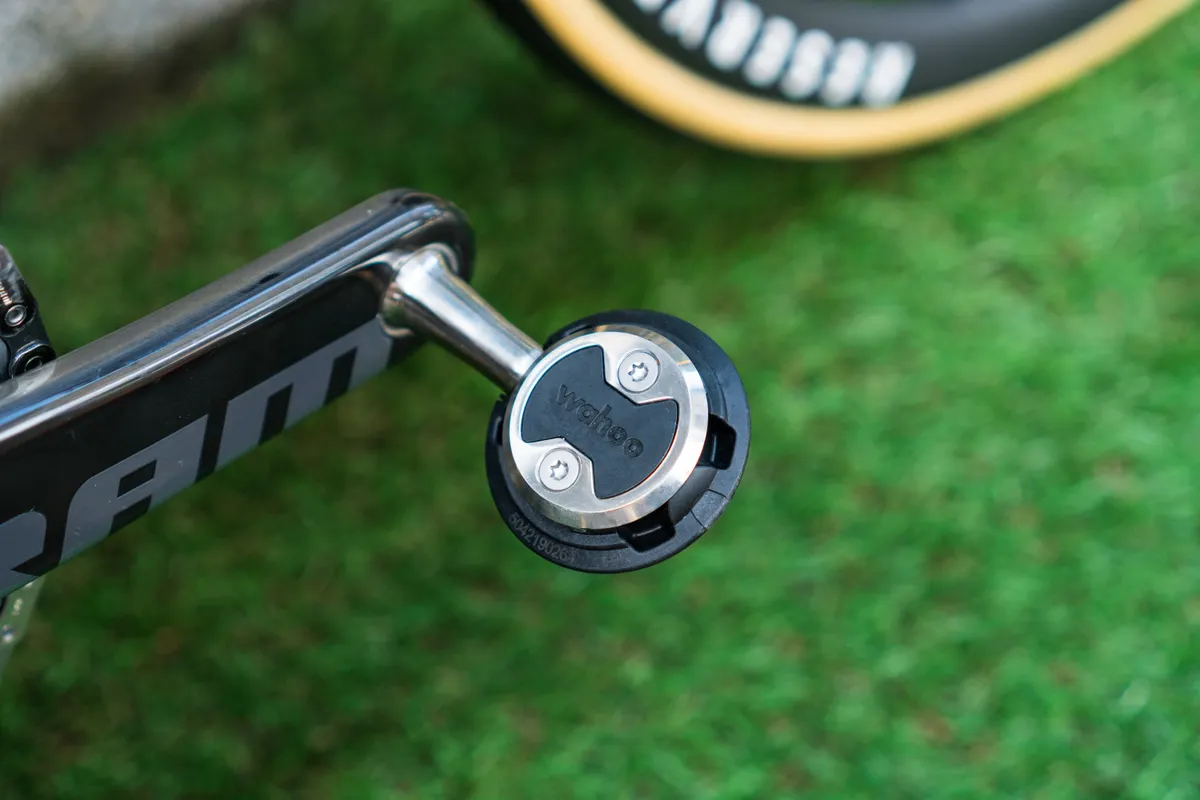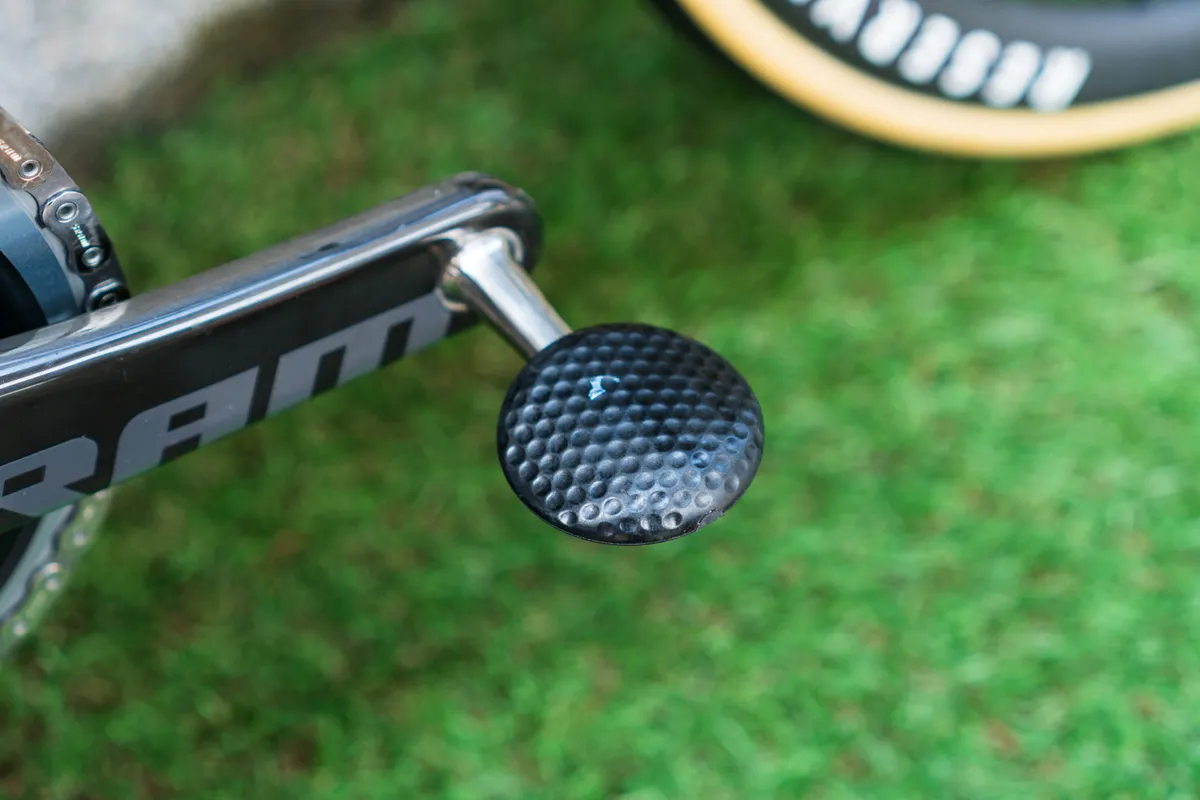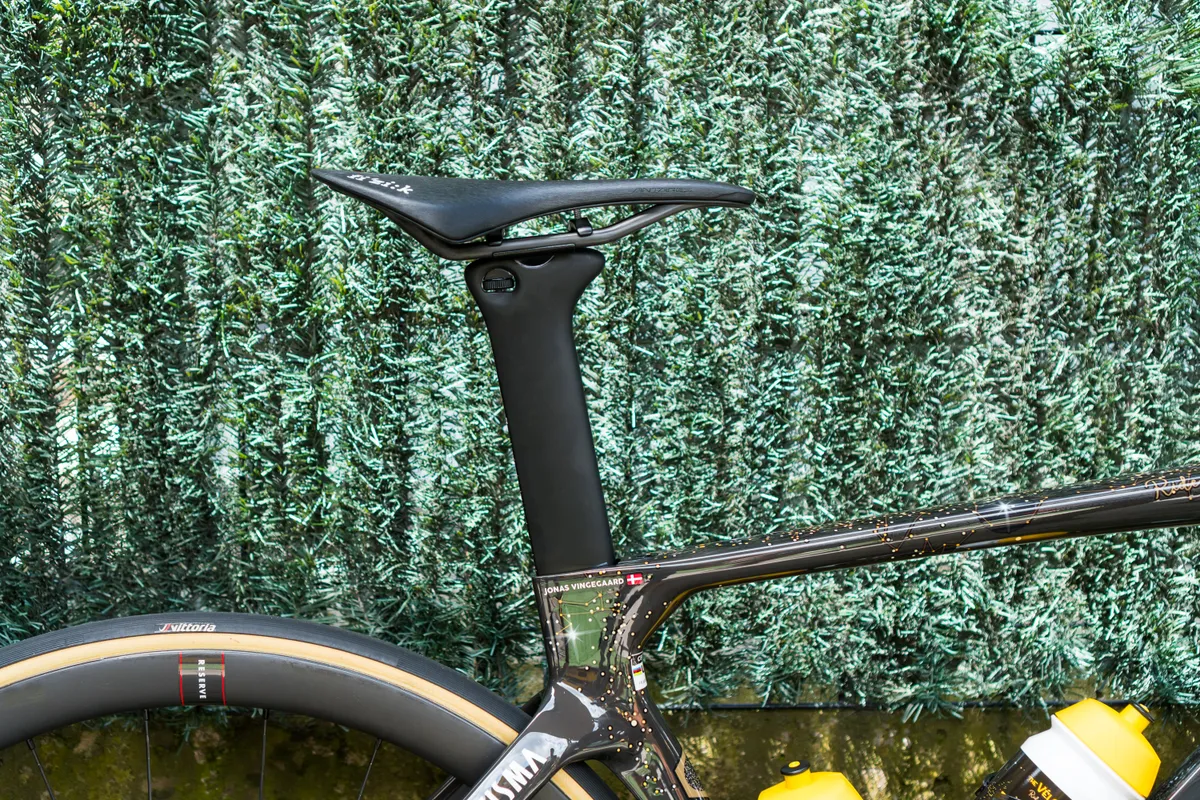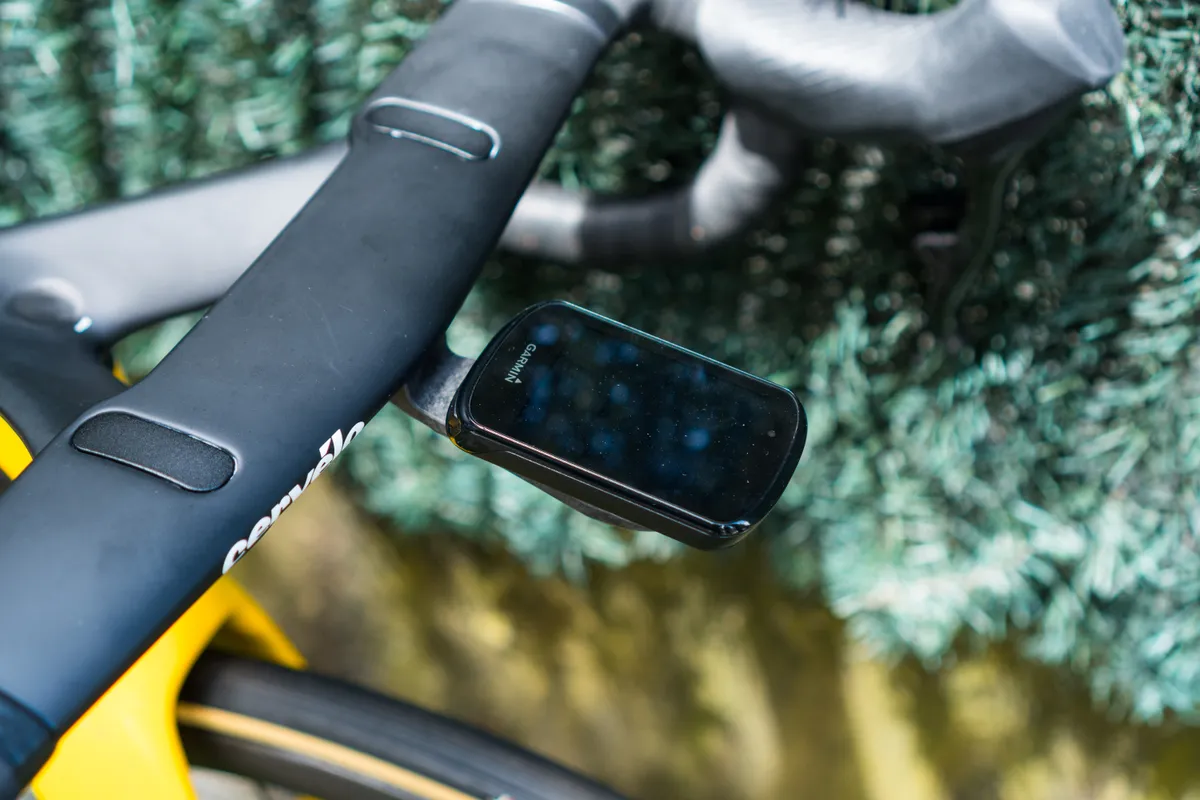Although Jonas Vingegaard has taken a commanding lead over Tadej Pogačar in the general classification battle at this year’s Tour de France, the race nevertheless looks set for a firework-filled dash to Paris.
Having tackled the only time trial in this year’s race on Tuesday, both the UAE-Team Emirates and Jumbo-Visma leaders are back on their team-issue road bikes for the rest of the race.
As you’d expect, both have access to some of the latest and greatest road bikes available, along with top-of-the-range components, wheels and tyres.
Being on different teams, though, each with its own blend of sponsors, means both riders have a number of options to choose from.
With that in mind, let’s take a look at the bikes of the two riders who have (so far) shaped this year’s race for the coveted yellow jersey.
Frameset | The luxury or tyranny of choice
Jonas’ Vingegaard’s Cervélo S5 and R5
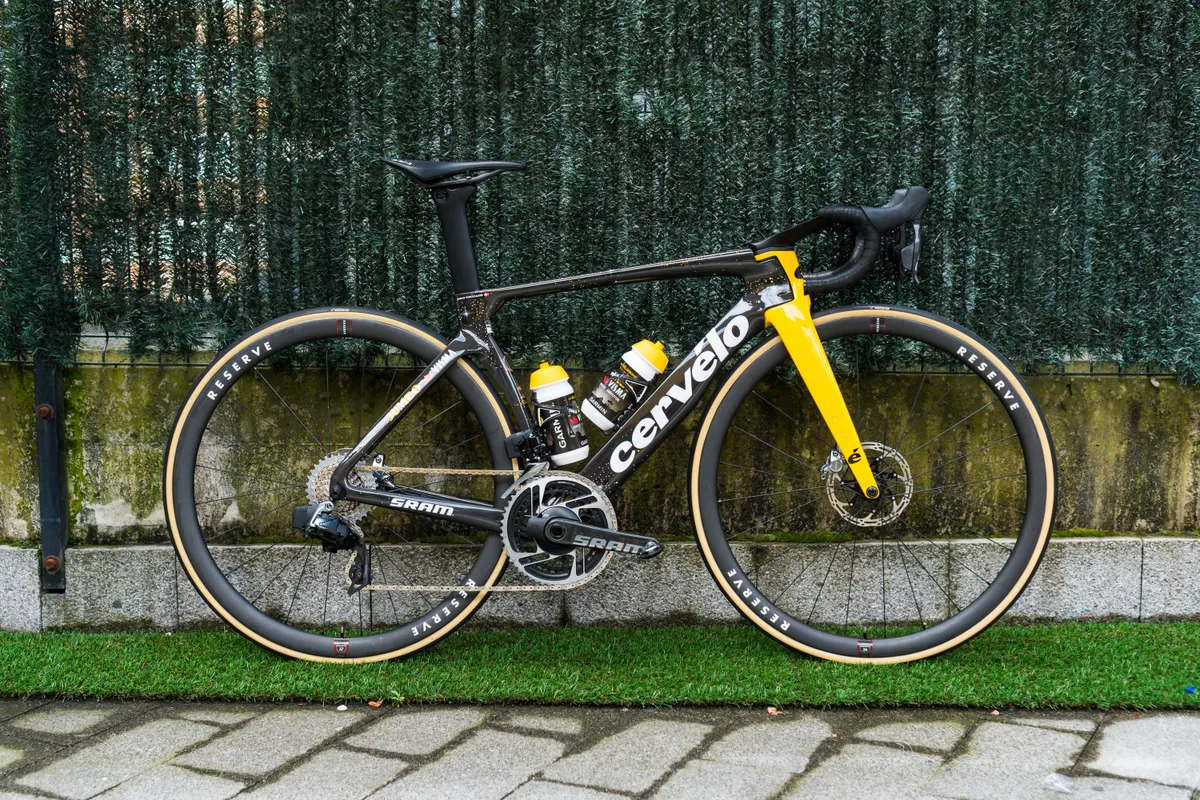
Jumbo-Visma is sponsored by Cervélo, so Vingegaard has the luxury of choice when it comes to his frameset.
The Dane started this year’s Tour de France aboard a Cervélo S5, the Canadian brand’s aero road bike.
The S5 is fully optimised for slicing through the wind, with deep truncated aerofoil tube shapes throughout, and an innovative V-shaped stem.
There are even distinct echoes of the Cervélo P5 time trial bike in the S5’s design, underlining its focus on aerodynamic efficiency.
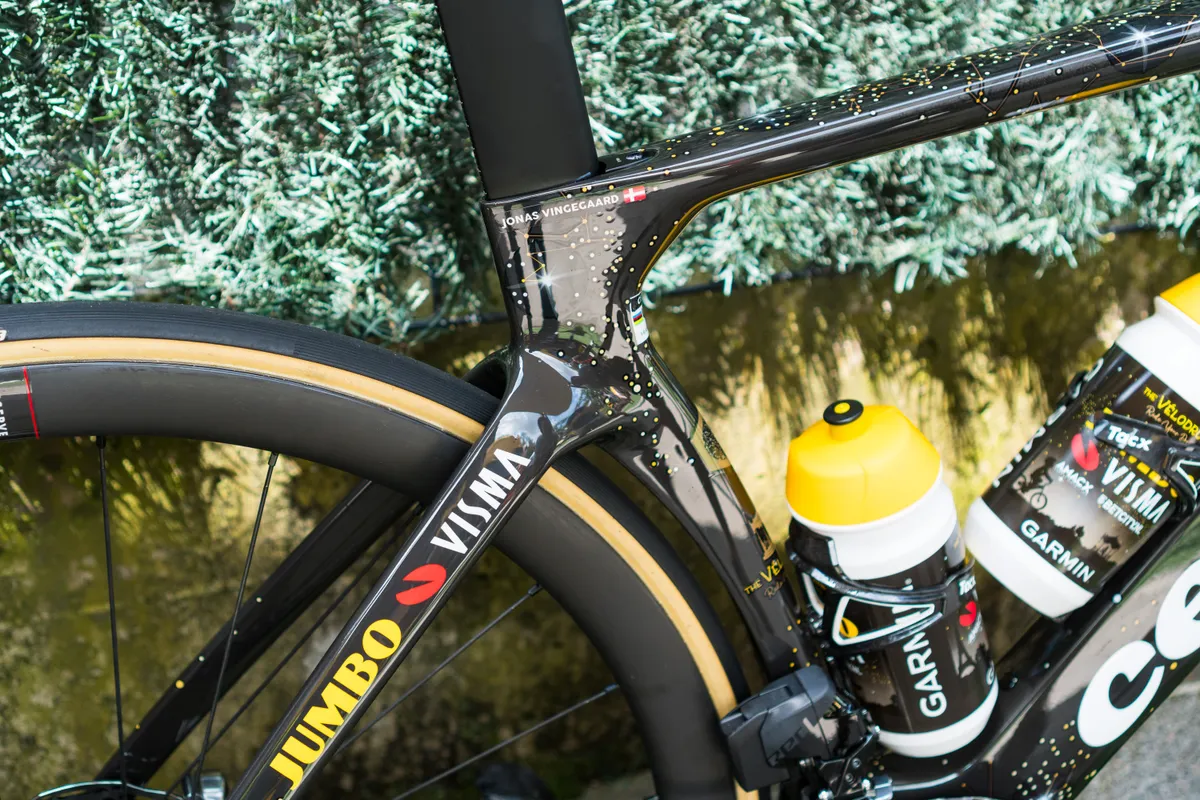
For stages in the high mountains, however, he’s also been using the Cervélo R5, the brand’s lightweight climbing bike.
Although this bike still incorporates aero detailing (and Vingegaard pairs his with an aerodynamic, integrated handlebar, as we’ll discuss later), it’s far more traditional in its shaping.
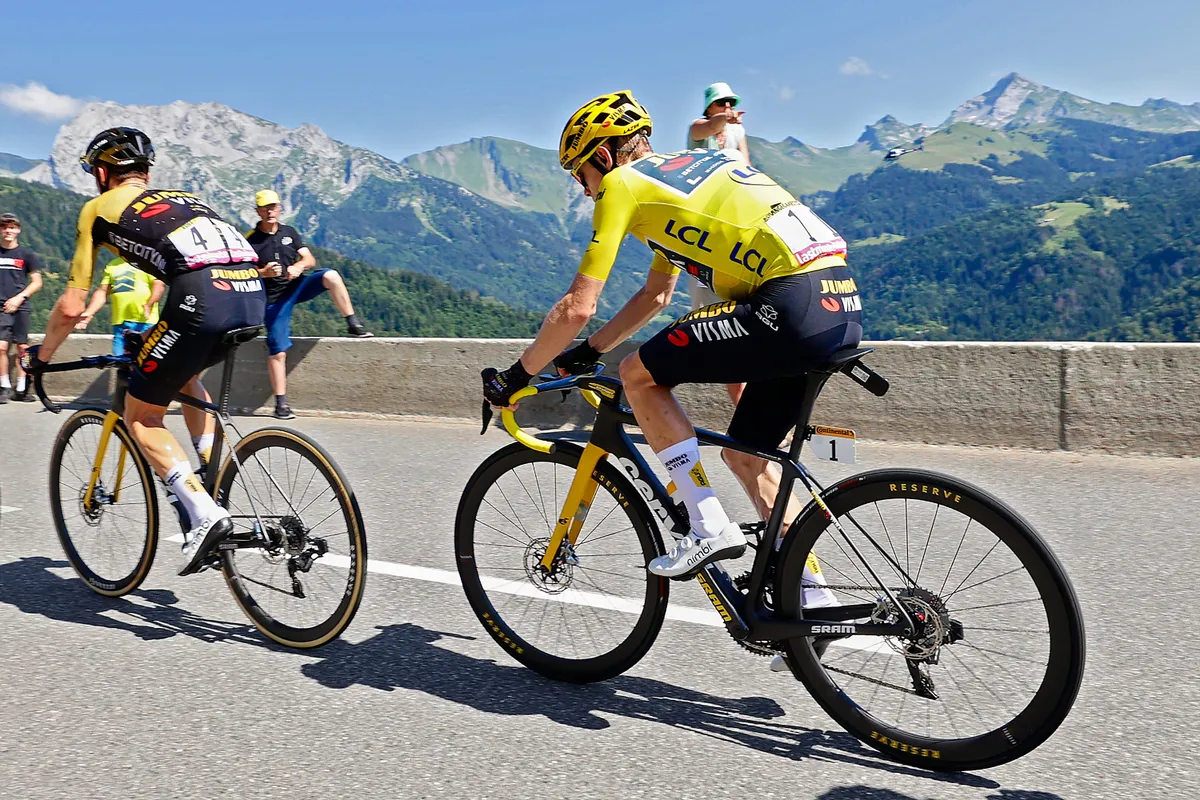
There are no dropped seatstays, rear-wheel hugging seat tube or hinge fork here. Instead, everything is about low weight, high stiffness and performance on long climbs.
It’s also worth noting Vingegaard and his teammates have access to yet more road framesets from Cervélo, beyond the S5 and R5.

There’s the aero-lightweight all-rounder Soloist, for example, which Jumbo-Visma used at this year’s Paris-Roubaix.
Said to be around 250g lighter than the S5, yet more aerodynamic than the R5, we had wondered if the Dutch team might use the Soloist at this year’s Tour for rolling stages. So far, though, it’s yet to make an appearance.
Cervélo also has the Caledonia endurance road bike in its catalogue, although given the S5, R5 and Soloist share its 34mm tyre clearance, it’s no surprise to see the pros lean towards the racier options, even for cobbled classics.
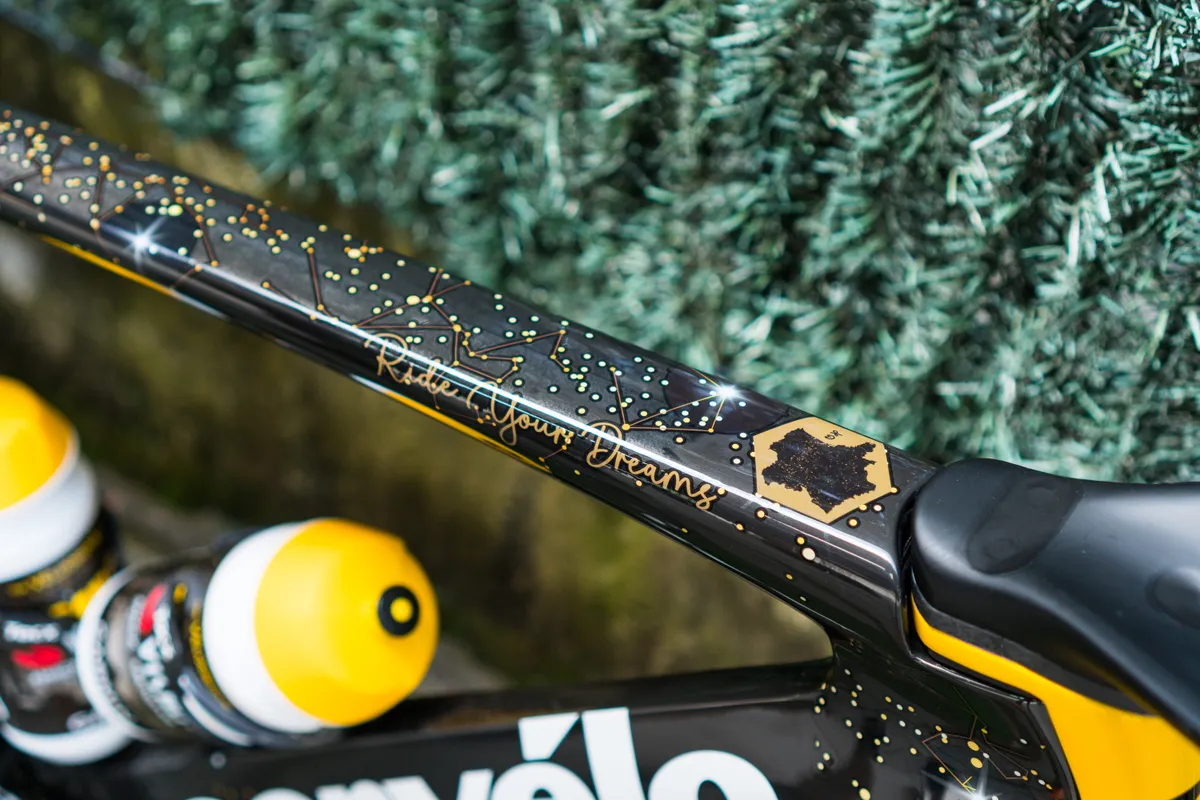
Tadej Pogačar’s Colnago V4Rs

For Pogačar, the choice is simpler. Colnago only makes two dedicated road framesets – the aero all-rounder V4Rs and the more classically styled C68.
Given the C68 makes next to no concession to aerodynamic efficiency – a key concern for any pro racing the Tour – it’s highly unlikely we’ll see it raced in anger at this year’s Tour (or any other, for that matter).
The only exception might be if Pogačar takes to the streets of Paris aboard a custom-painted C68 – purely for the sake of marketing, considering the Tour’s final stage is a largely ceremonial affair for the general classification – should he reach the final stage in the race leader’s yellow jersey.
Failing that, we expect Pogačar will race the V4Rs for every stage, as he has done so far.

The V4Rs was first unveiled as the Colnago Prototipo just before the 2022 Tour de France, before eventually being officially launched in December that year.
Designed with input from Pogačar himself, the V4Rs is designed to be both aerodynamic and lightweight.
It’s a similar philosophy to that used by Ineos-Grenadiers' Pinarello Dogma F and Jayco-Alula’s Giant Propel Advanced SL.
According to Colnago, the V4Rs is 3 per cent more aerodynamic than the V3Rs, at an almost identical weight.
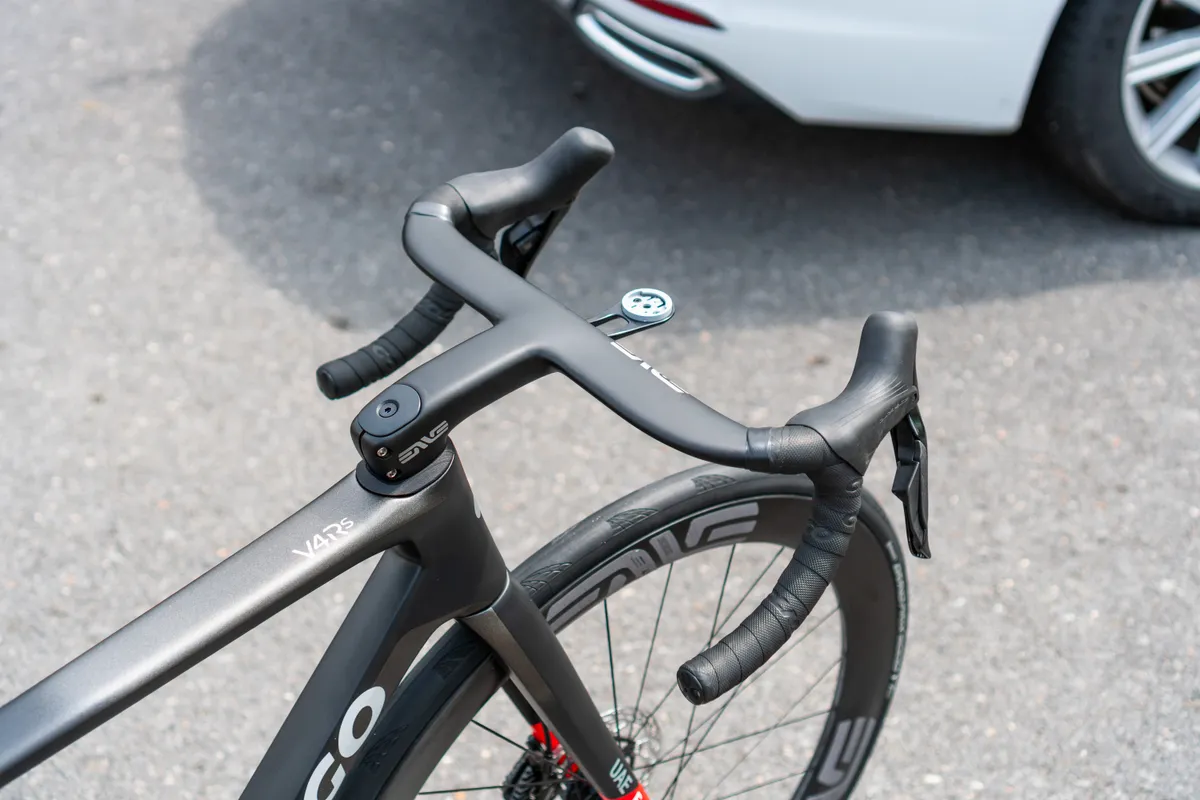
Pogačar’s bike may be even slippier, though, because he’s paired his with a new ENVE integrated handlebar (which we’ll discuss in more detail later).
Is there an element of compromise with a ‘one bike fits all’ approach? Perhaps, although this could also simply be what Pogačar prefers.
Colnago has previously made dedicated aero road bikes, such as the Colnago Concept, so we’re sure it would be open to making another (plus a dedicated lightweight bike for mountain stages) if Pogačar or his team requested it.
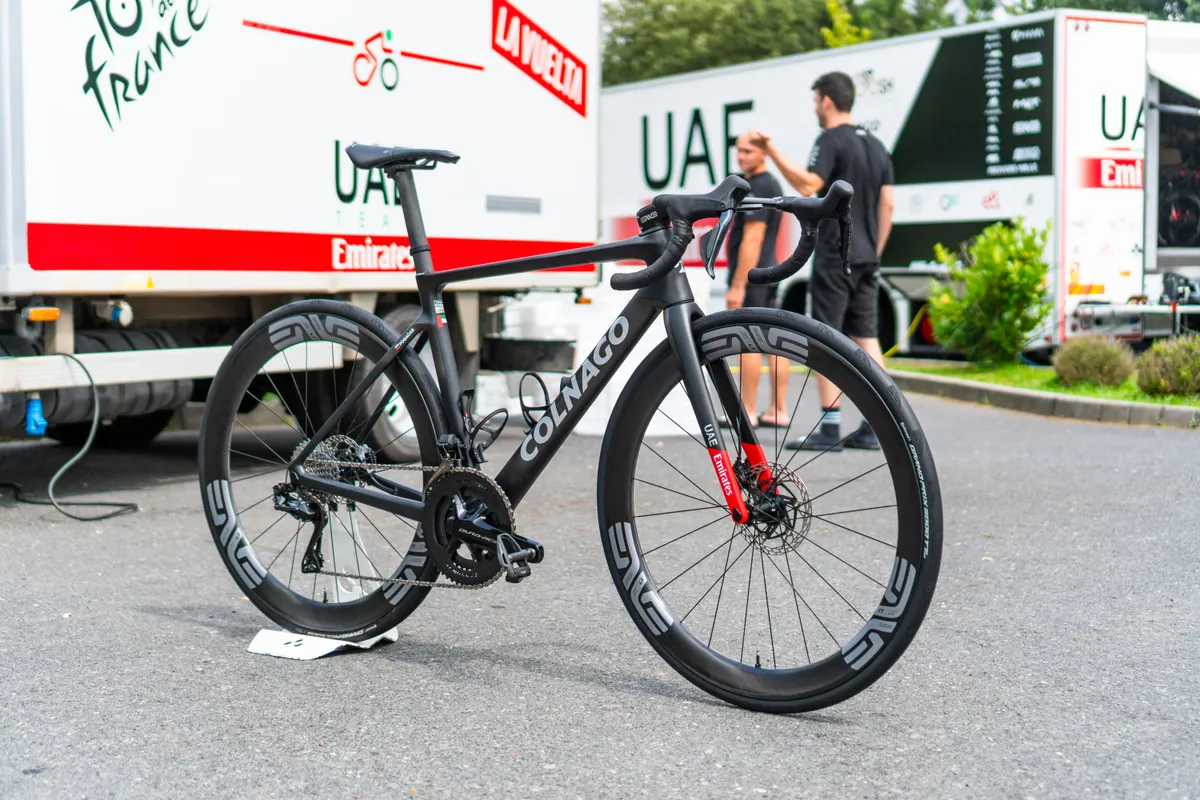
Drivetrain | Battle of the titans
Vingegaard’s SRAM Red eTap AXS
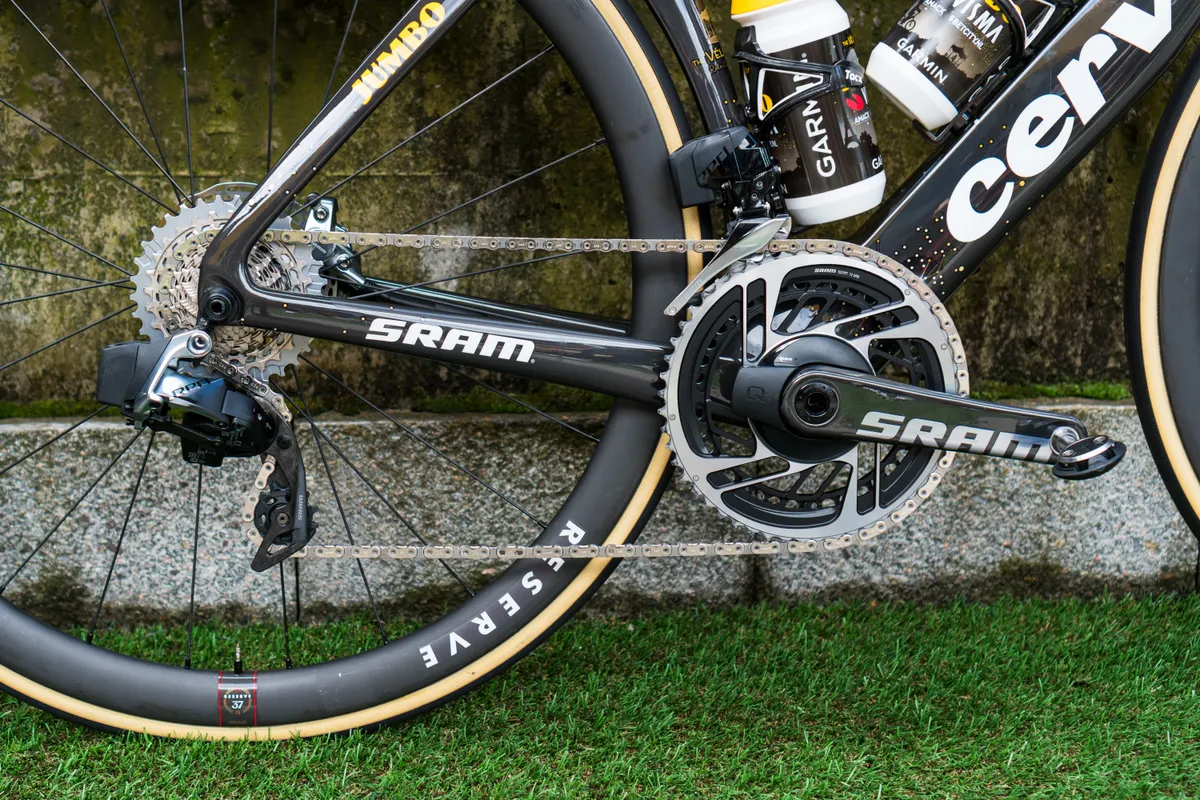
Vingegaard’s bike is adorned with top-of-the-range SRAM Red eTap AXS drivetrain components.
When we photographed one of his S5s prior to the race start in Bilbao, Spain, Vingegaard’s bike was equipped with a 2x drivetrain.
This bike had 52/39t chainrings paired with a wide-ranging 10-33t cassette out back.

As revealed in our 2023 Tour de France tech trends article, though, Vingegaard and a few other SRAM-sponsored riders have also been using 1x drivetrains at this year’s Tour for certain stages.
Because they’re integrated into the chainrings at the Red and Force AXS level, it’s no surprise to see Vingegaard and the rest of his teammates employing SRAM Red AXS power meters (which use the same internals as the highly rated Quarq DFour DUB power meter).
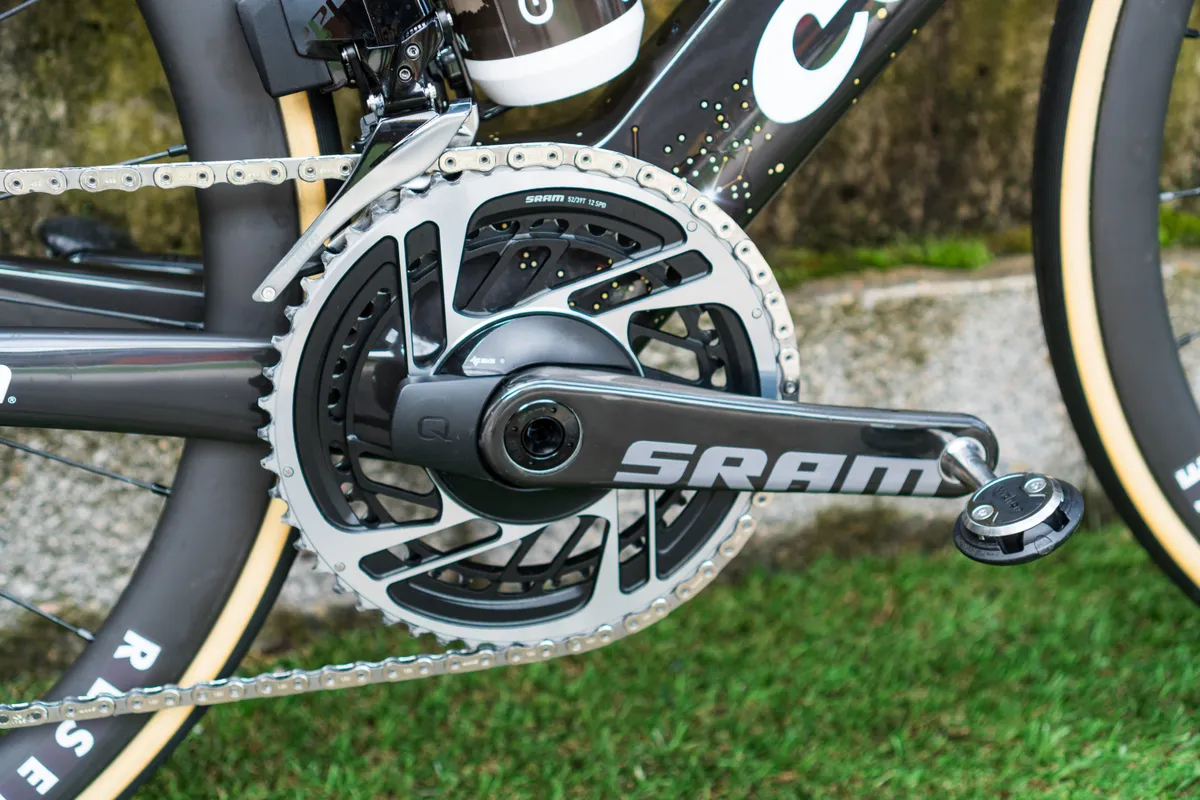
Vingegaard’s bike also had a set of the recently updated SRAM Force AXS shifters (albeit with custom ‘pro’ graphics that make the SRAM logos more prominent).
According to a SRAM representative, Vingegaard prefers the new shape of the nominally second-tier Force AXS hoods, as well as the fact that they’re a little lighter than the Red-level ones.
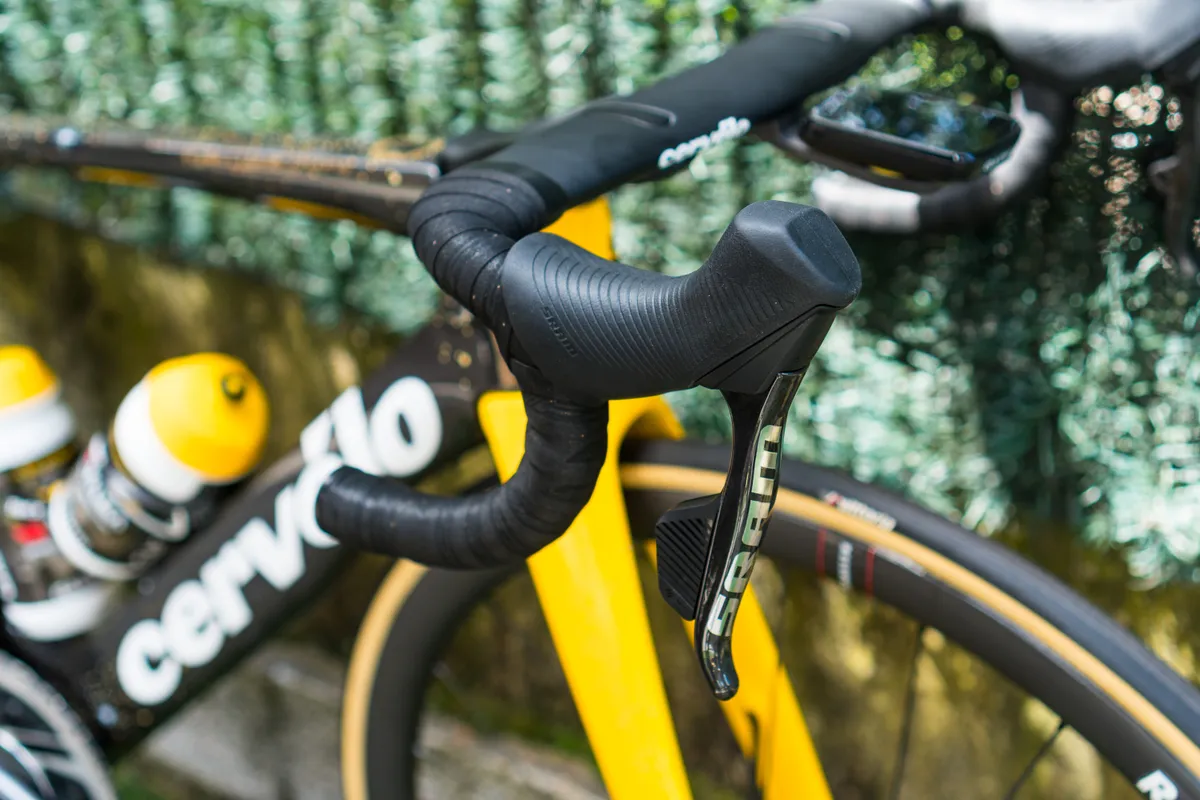
Pogačar’s upgraded Dura-Ace Di2 R9200
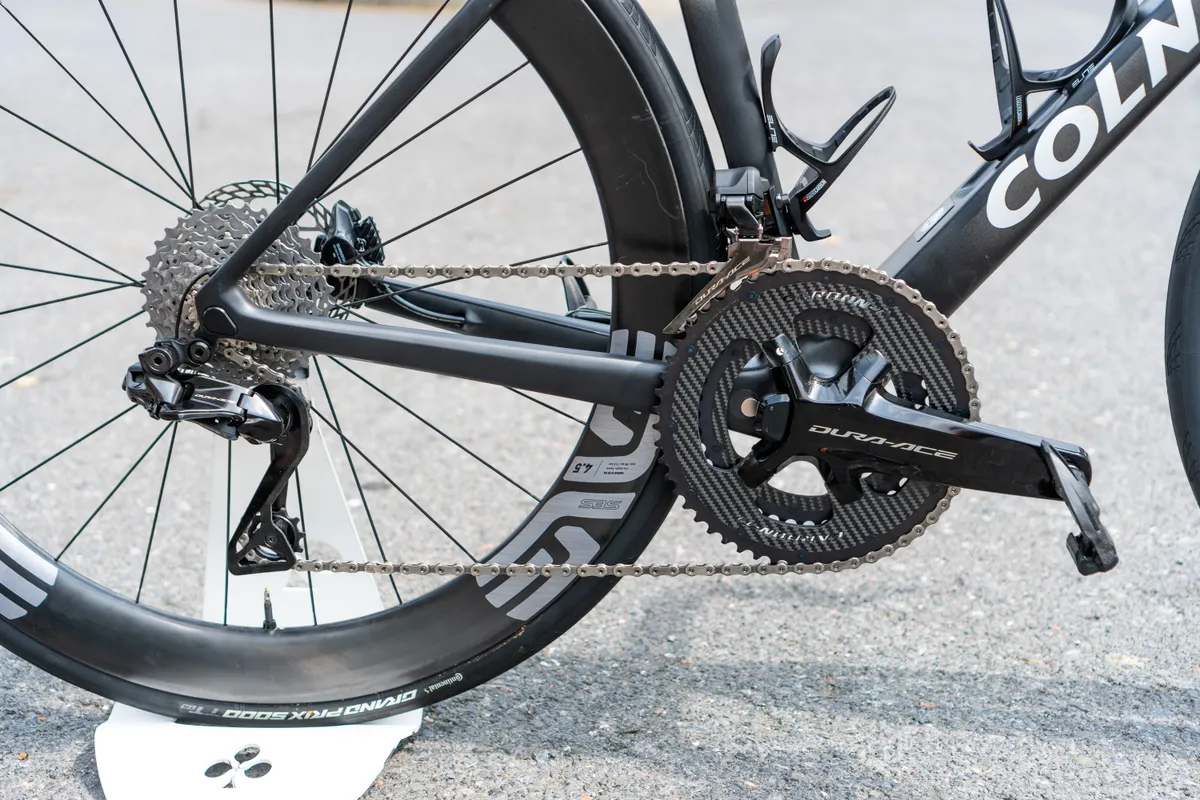
With Pogačar’s team being sponsored by Shimano, it’s no surprise to see his bike equipped with a Shimano Dura-Ace Di2 R9200 groupset.
The Slovenian road and time trial national champion (and current holder of the white jersey) has used a 2x setup for every stage in this year’s race, so far.
Whether that’s because Shimano’s road bike groupsets don’t officially support 1x use, or because Pogačar simply prefers a 2x setup, we’re not sure.

Pogačar has used 1x for time trials at the Tour in previous years, though, so it’s clearly something he’s open to under the right circumstances.
Like most other Shimano-sponsored riders, Pogačar’s bike was equipped with 54/40t chainrings (which replaced the old 53/39t ‘standard’ double-chainring setup in Shimano’s latest Dura-Ace groupset), paired with an 11-34t cassette out back.
Pogačar is also using Shimano’s latest Dura-Ace FC-R9200-P dual-sided power meter crankset.
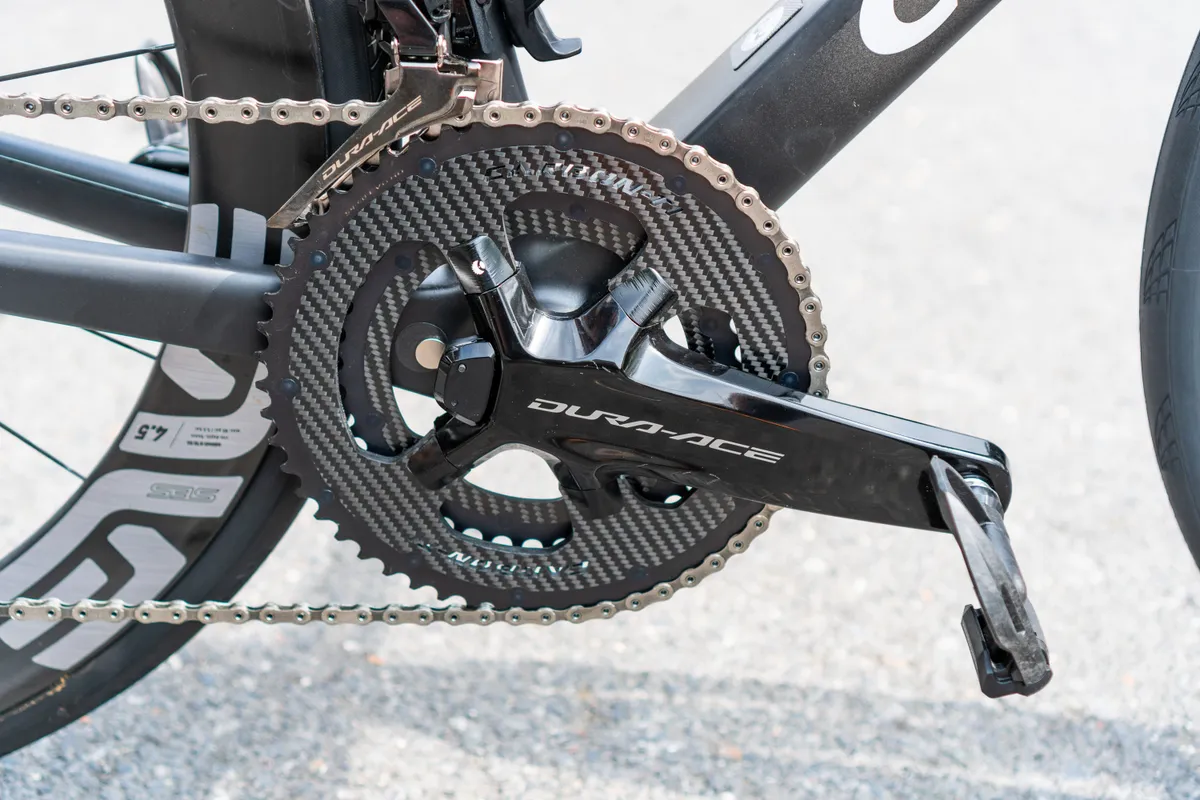
In a notable deviation from Shimano’s standard equipment, Pogačar’s bike is equipped with CarbonTi X-CarboRing EVO carbon chainrings.
With claimed weights of 114g for the 54t and 47g for the 40t, these chainrings are presumably slightly lighter than stock Dura-Ace versions (we’re not sure how much, unfortunately, as Shimano doesn’t offer weights for these chainrings on its website).
CarbonTi is listed as an ‘official supplier’ of Pogačar’s team, which is handy because this upgrade would otherwise cost well over €400 per set.
Wheels and tyres | Divergent philosophies
Vingegaard’s many options
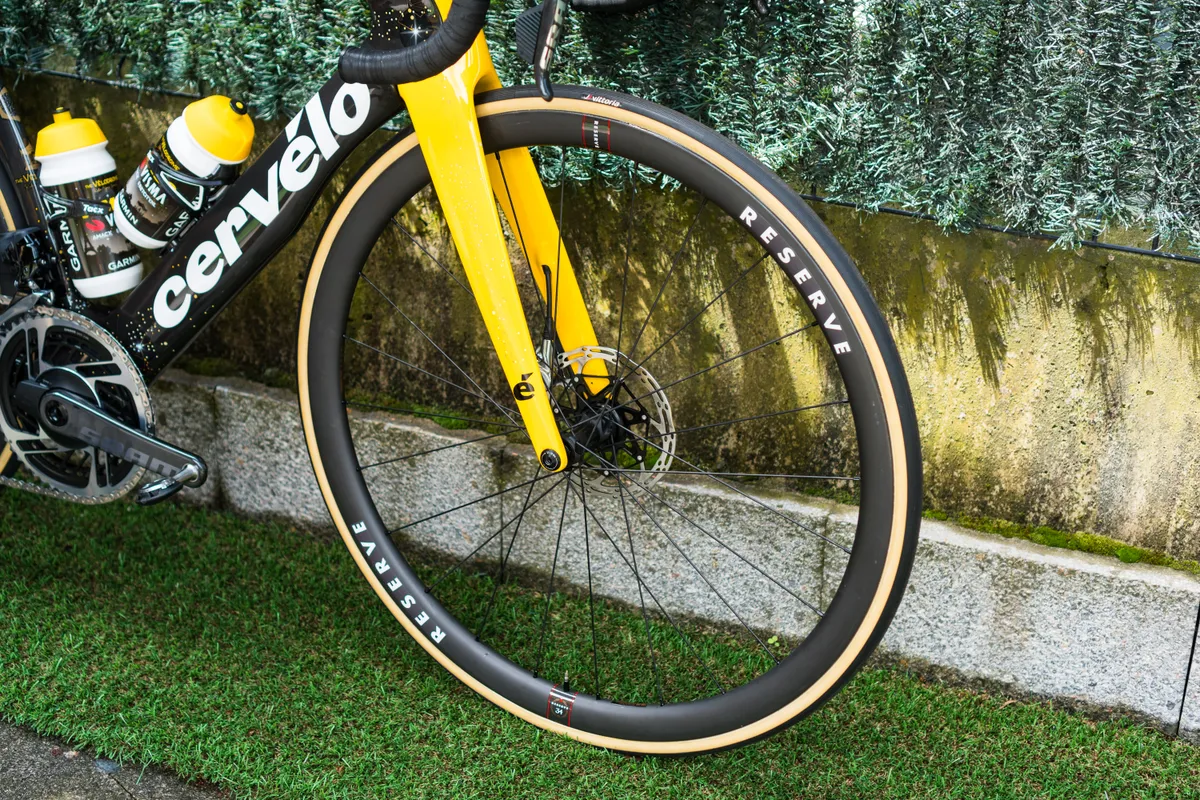
As with his frameset and drivetrain, Vingegaard has also been swapping between different wheel and tyre setups depending on the varying demands of each stage.
As discussed in our Tour tyre tech deep dive, Vingegaard’s bike was equipped with unusually narrow 24c Vittoria Corsa Pro tubular tyres on a Reserve 34|37 wheelset at this year's Grand Départ.

Throughout the race, though, Vingegaard has also used tubeless setups based on Reserve’s 40|44 wheelset and Corsa Pro TLR or Vittoria Corsa Speed G2.0 TLR tyres (Vittoria’s time trial-specific model).
What’s more, we spotted Vingegaard was using Corsa Pro Speed TLR tyres in yesterday’s time trial – a model which has yet to be officially released.

Wide rims and tyres for Pogačar
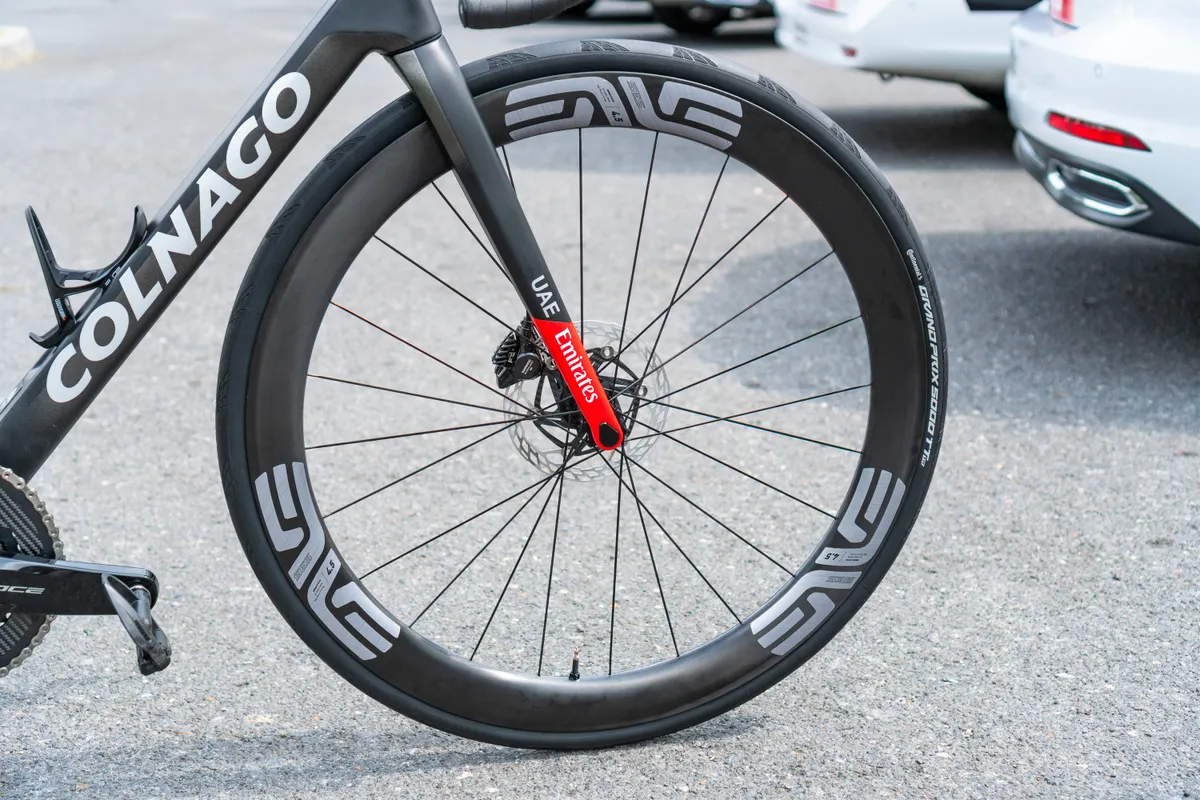
Again in contrast, Pogačar has stuck with a fairly consistent wheel and tyre setup throughout the race.
On most stages, Pogačar has been using an ENVE SES 4.5 wheelset paired with 28c Continental GP5000 TT TR tubeless tyres – Conti’s latest time-trial specific option.
Thanks to the cavernous, 25mm internal width of the ENVE rims, these 28c tyres balloon up to 31.3mm-wide at the front, and 32.2mm-wide at the rear.

In contrast to Jumbo-Visma’s tyre sponsor, Vittoria, Continental hasn’t updated its tubular offerings in a long time.
Likewise, ENVE’s latest wheels are all tubeless-ready (and have hookless rims, which require the use of tubeless tyres), too.
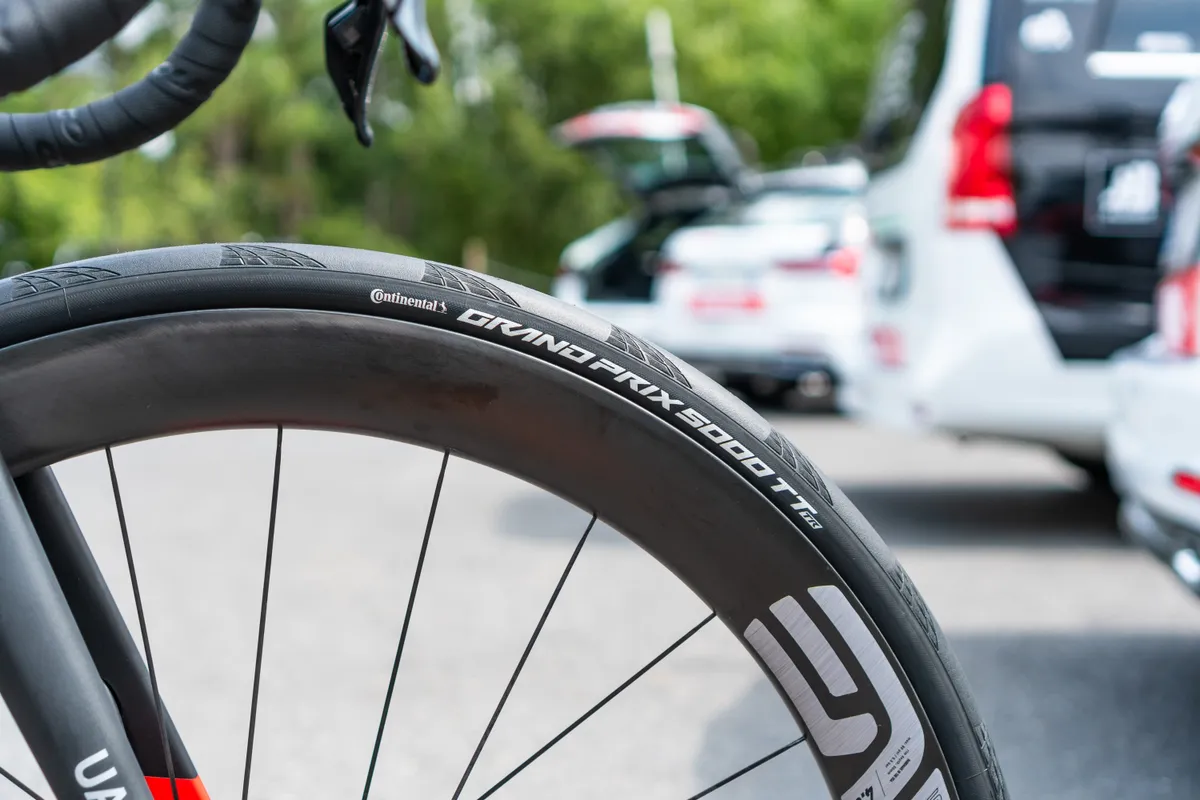
Given this, Pogačar has stuck with tubeless setups for every stage.
The only deviations from the above combination have been to ENVE’s lighter 2.3 climbing wheelset for steep mountain-top finishes, and to AeroCoach Aeox wheels for the time trial on stage 16.

Finishing kit | Bling galore for Pogačar
Stock spec to finish off Vingegaard’s bikes

Finishing kit is one area where Vingegaard seems happy to stick with relatively stock options.
On his S5, Vingegaard is using the proprietary V stem and integrated handlebar, with a 120mm stem and a 38cm-wide handlebar (measured centre to centre at the brake hoods).

On his R5, which uses a D-shaped steerer tube capable of pairing with both integrated and non-integrated setups, Vingegaard is using a Vision Metron 5D integrated handlebar.
Vingegaard opts for Fizik’s Vento Antares 00 saddle, which has a claimed weight of just 118g for the 140mm-wide model.
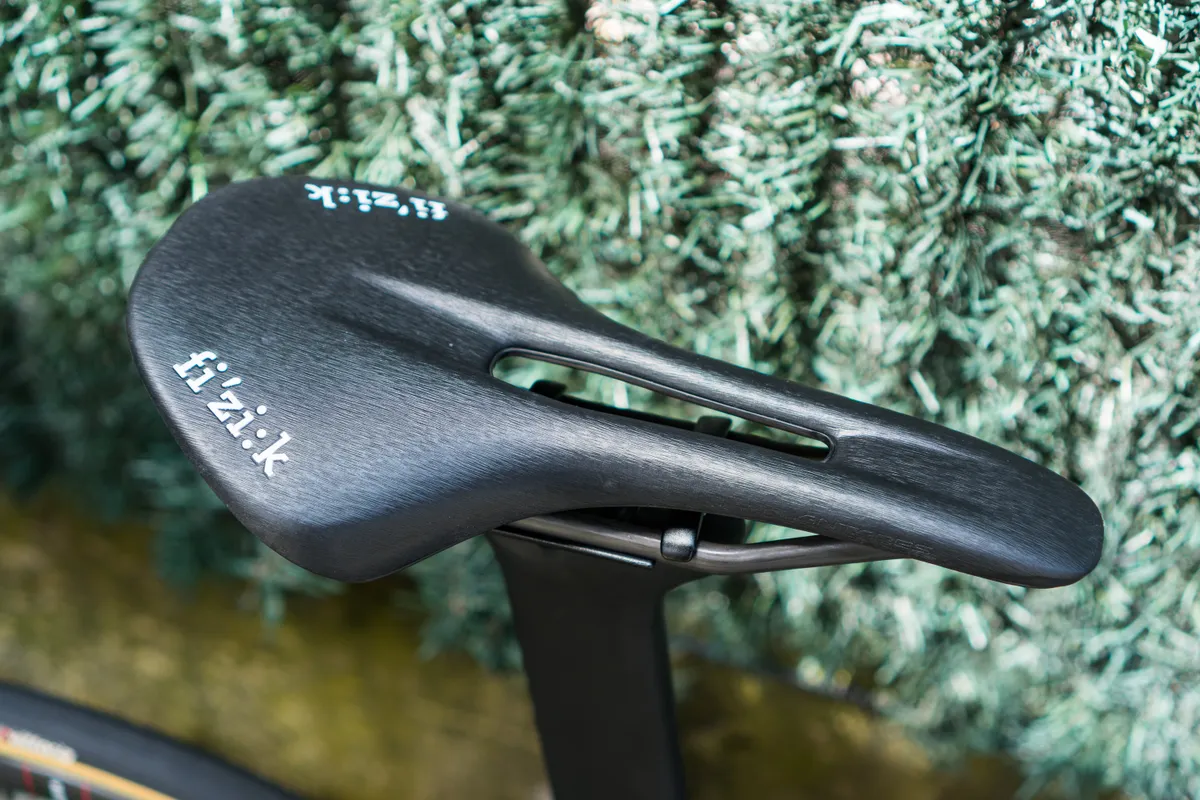
He also uses Wahoo Speedplay Aero pedals, which ditch dual-sided entry for a dimpled, aerodynamically optimised bottom side.
Vingegaard’s bike is finished off with a set of Tacx Ciro carbon bottle cages and a Garmin Edge 830 bike computer.
Flash upgrades for Pogačar

It’s here where Pogačar’s bike comes into its own.
For a start, it has ENVE’s unreleased one-piece handlebar, instead of the stock Colnago option.
It’s not clear what the performance advantage would be compared to Colnago’s integrated bar, but ENVE confirmed the handlebar has been designed around Pogačar’s requirements and isn’t an off-the-shelf piece of tech.
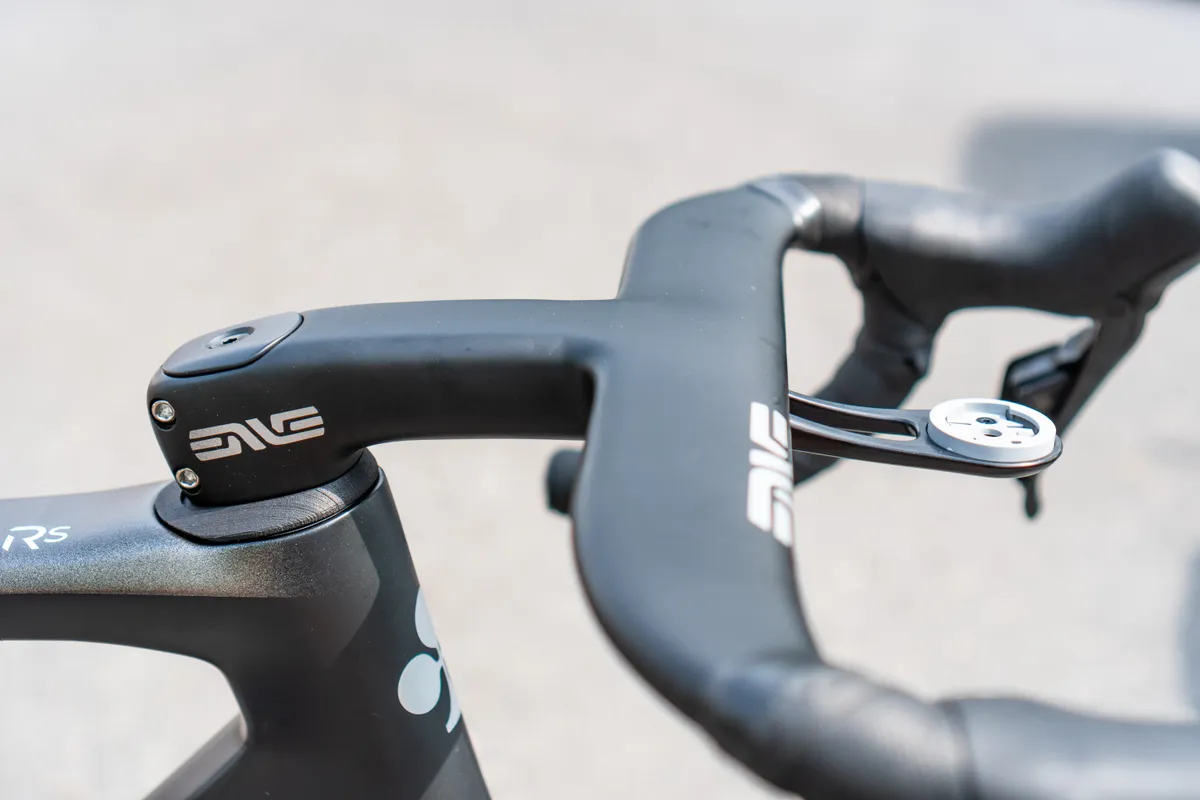
At a glance, the integrated handlebar appears to combine ENVE’s existing Aero Road stem and its flared Aero Handlebar.
Although it can be tricky to tell with integrated setups, Pogačar’s stem appeared to be around 120 to 130mm long, and was paired with a 36cm-wide handlebar (again, measured centre to centre at the brake hoods).
Pogačar also has Di2 sprint shifters positioned to enable him to shift with his thumbs when holding the drops.
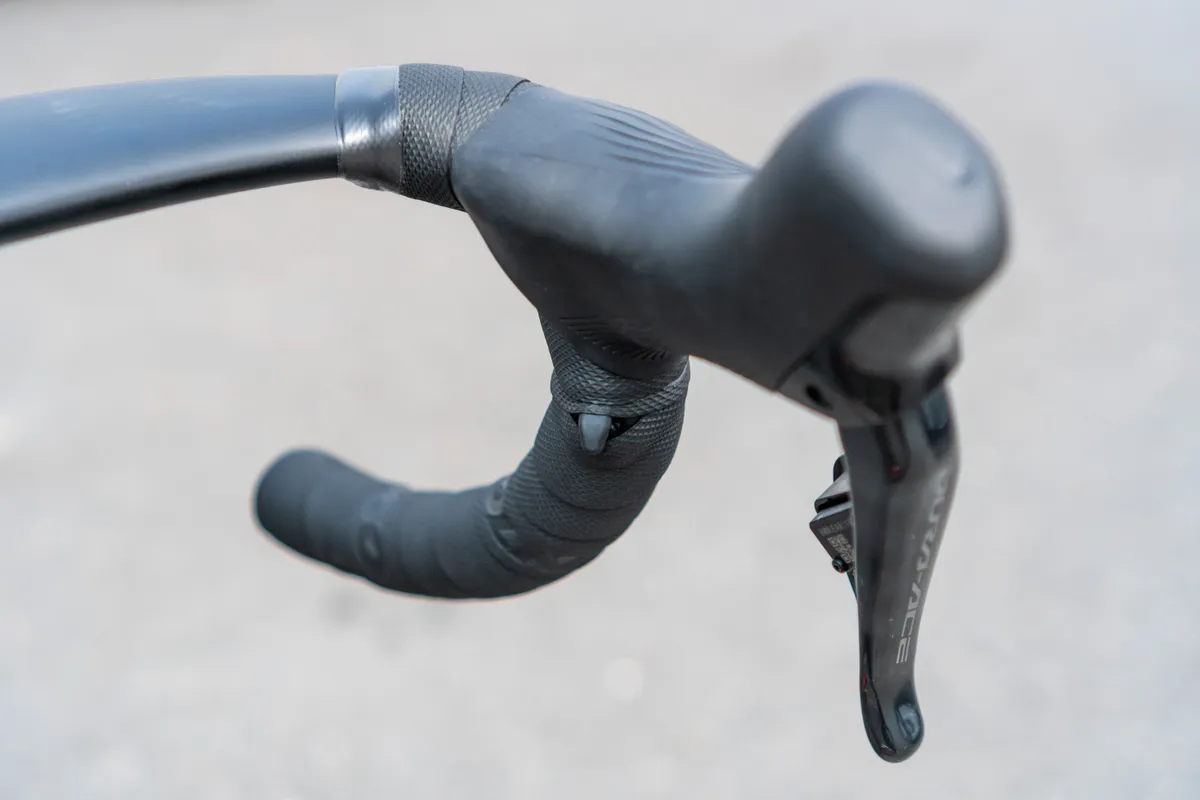
Elsewhere, Pogačar has even more carbon bling.
His ENVE wheels are equipped with CarbonTi X-Rotor SteelCarbon 3 carbon disc brake rotors, with 160 and 140mm rotors front and rear.

These have a claimed weight of 98 and 86g each, and cost €220 per rotor.
Compared to the latest Dura-Ace RT-CL900 rotors, that saves just 23g per set, so it's a truly marginal gain.

Pog’s seatpost also appeared to be a non-standard affair.
With an unpainted, unidirectional carbon finish, it bears a strong resemblance to the ultra-light carbon seatposts made by Spanish brand Darimo.
Of course, it might also just be a standard team-issue post with the paint stripped off to save a few grams.
Either way, it’s clear Pogačar (or someone on his team) has sweated the fine details for the two-time Tour winner’s bike.
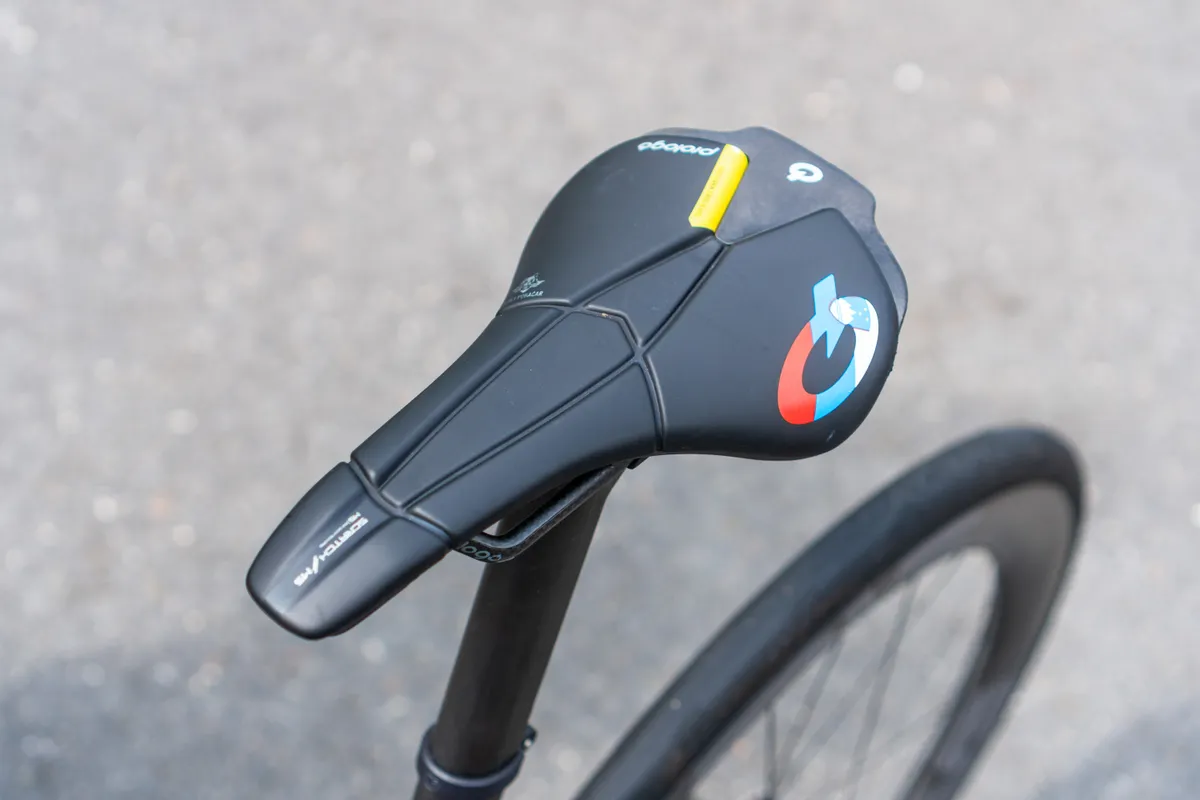
Pogačar uses a special-edition Prologo Scratch M5 saddle, which celebrates his Tour de France victories in 2020 and 2021.
As you’d expect, it has carbon rails to keep things light, and a claimed weight of 180g.
Pogačar uses Shimano’s flagship Dura-Ace PD-R9100 pedals – one of the most popular pedals in the peloton.
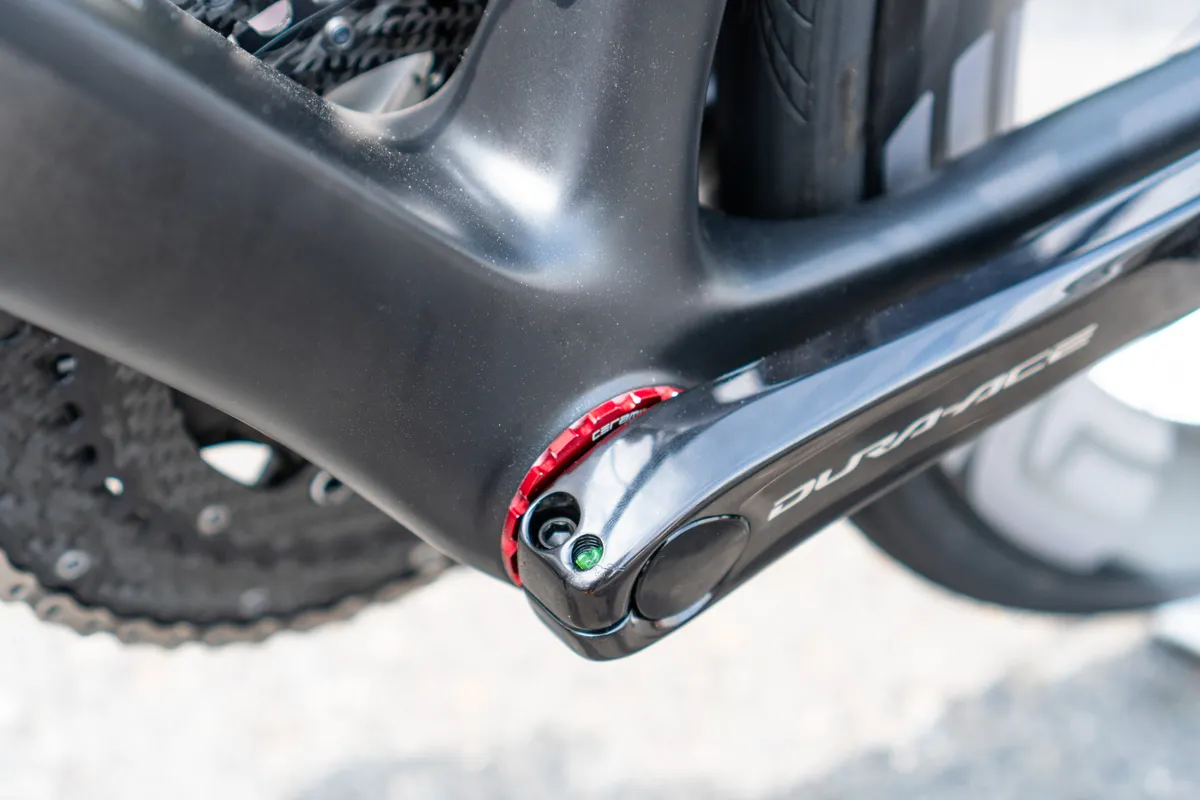
Finishing things off, Pogačar’s bike has a CeramicSpeed bottom bracket (which is presumably fitted with ceramic bearings) and a set of Elite Leggero Carbon bottle cages.
When we saw Pogačar’s bike at the Grand Départ, it wasn’t equipped with a bike computer, but the team is sponsored by Wahoo and Pogačar appears to favour the Elemnt Bolt.
Weight | Lightweight bikes for lightweight riders
Vingegaard’s flyweight aero bike

Vingegaard has changed his bike setup on a regular basis throughout this year’s Tour, but when we weighed his S5 before the start of the race, it was a surprisingly svelte 7.195kg.
Granted, it had narrow tyres mounted on shallow tubular rims, but that’s still impressive for a proper aero road bike, with pedals and bottle cages.
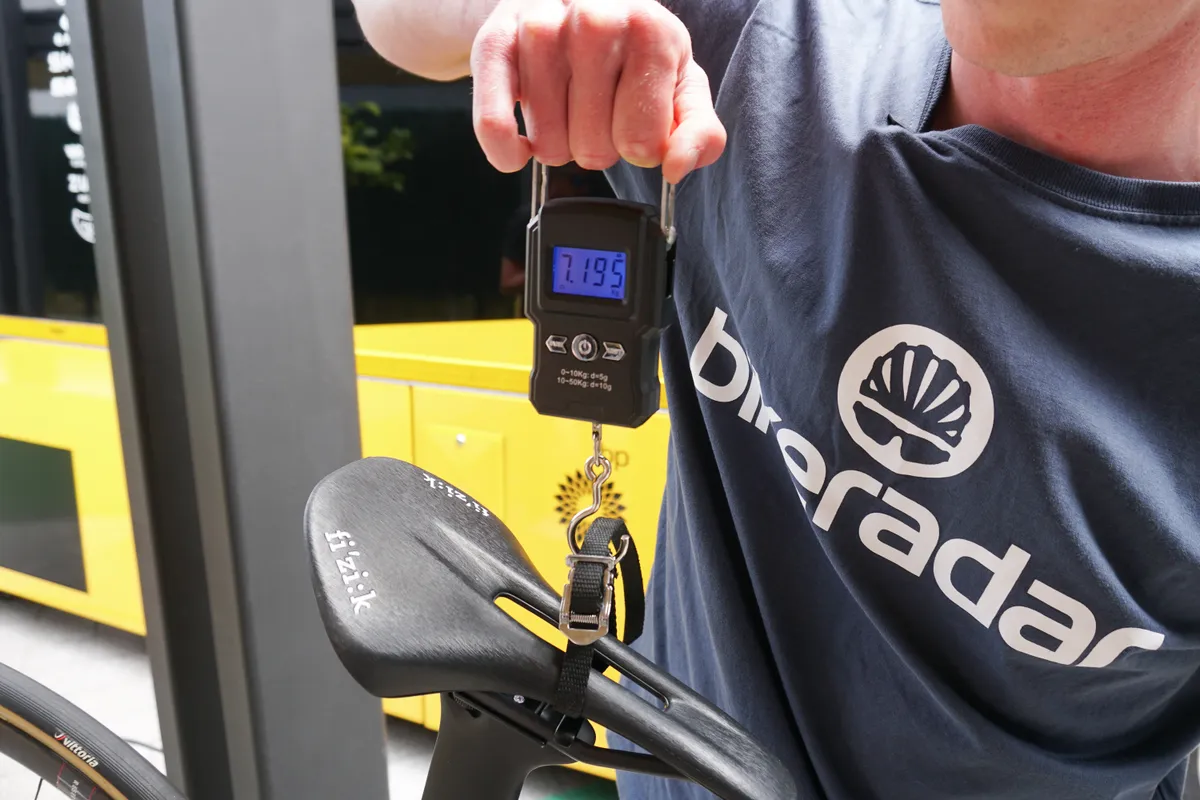
Would switching to the R5 be enough to tickle the UCI’s minimum bike weight limit of 6.8kg? It’s certainly possible.
Pogačar’s not so lightweight all-rounder?
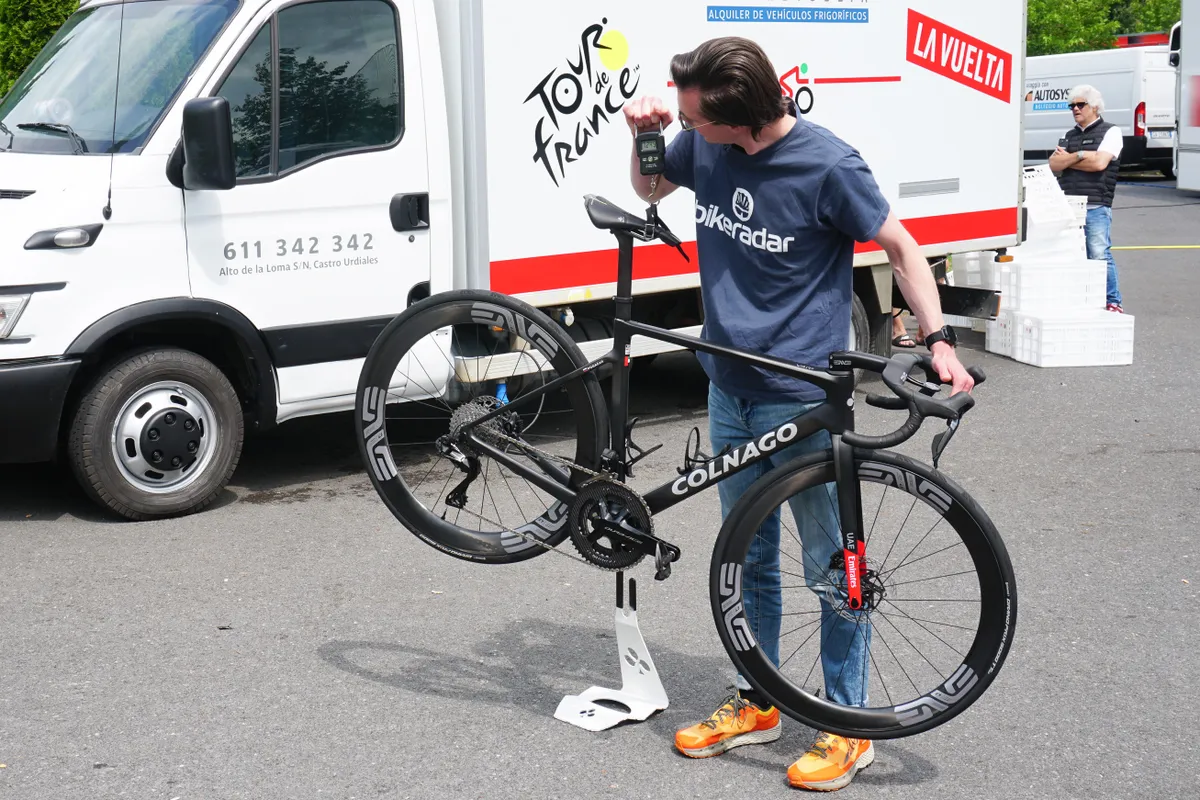
Given it was dripping with all manner of expensive carbon upgrades, we assumed Pogačar’s bike would be very close to the hallowed 6.8kg mark.
Surprisingly, though, it came in at 7.245kg on our scales – more than 400g over the UCI weight limit.
Of course, compared to Vingegaard’s S5, that’s a difference of just 50g, and while Vingegaard’s aero bike was equipped with climbing wheels and tyres, Pogačar’s Colnago had exceptionally wide rims and tyres.

Switching to the ENVE 2.3 climbing wheelset ought to save Pogačar a claimed 255g, and if paired with narrower, lighter 25c tyres, it’s possible to save another 40g or so there (we weighed a 25c GP5000 TT TR tyre at 230g, while a 28c tyre weighed 252g on our scales).
When it mattered, then, it’s likely Pogačar’s bike wouldn’t have been too far off the minimum permitted weight.
Which bike will win the 2023 Tour de France?
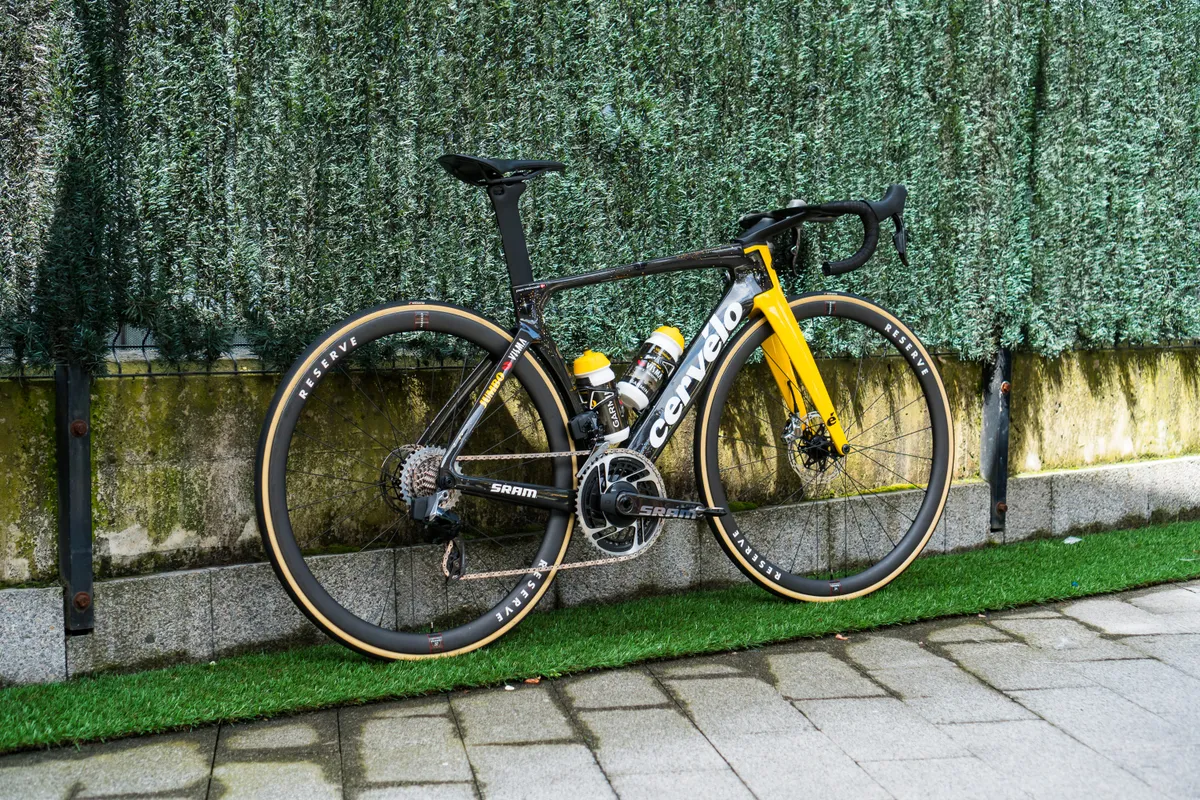
It’s the rider that wins the Tour, of course, and – as things stand – it looks as if Vingegaard and his fleet of Cervélos have taken a decisive lead in the race for the yellow jersey.
Even with more than seven and a half minutes now separating Vingegaard and Pogačar, though, we're sure Jumbo-Visma won’t be taking anything for granted as the peloton speeds towards Paris.
Whatever happens, it’s been an exciting Tour for bike tech nerds, and it has been fascinating to see the diverging and evolving setups of two titans of the Tour de France.
